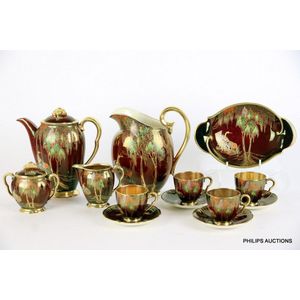Carlton Ware Rouge Royale Chinoiserie Demitasse Service
You must be a subscriber, and be logged in to view price and dealer details.
Subscribe Now to view actual auction price for this item
When you subscribe, you have the option of setting the currency in which to display prices to $Au, $US, $NZ or Stg.
- Circa - A Latin term meaning 'about', often used in the antique trade to give an approximate date for the piece, usually considered to be five years on either side of the circa year. Thus, circa 1900 means the piece was made about 1900, probably between 1895 and 1905. The expression is sometimes abbreviated to c.1900.
- Attributed - A cataloguing term where the item in the opinion of the cataloguers, is a of the period of the artist, craftsman or designer, and which probably in whole or part is the work of that person.
- Chinoiserie - Furniture and decorative items decorated in imitation of a Western interpretation of the Chinese style. The Chinoiserie style first became popular in the late 17th century, though there were frequent revivals, notably by Chippendale (hence 'Chinese Chippendale') during the Regency period, and the Anglo-Japanese style in the second half of the 19th century.
The ubiquitous 'willow pattern' is the most common 'Chinese' theme used in porcelain, while on furniture the Chinoiserie style usually has black or red painted and lacquered decoration, though the hallmark of the furniture style is the use of fretwork in geometrical patterns, pagodas and other decorative forms.
Japonaiseries, as the name implies, are motifs in imitation of the Japanese taste.
See also "Chinese Chippendale". - Bonbon Dish - A bonbon dish is a type of serving dish that is specifically designed to hold small, bite-sized candy or chocolates, which in the 19th century were also known as bonbons. They were often used for special occasions, like parties, weddings and holidays. They are also a common serving piece for after-dinner desserts, such as chocolates.
These dishes are often decorative and can be made from a variety of materials such as silver, glass, crystal, metal, or porcelain. Bonbon dishes come in many different shapes and sizes, but most are relatively small, and have a shallow bowl or dish shape.
This item has been included into following indexes:
- Carlton Ware (England), colourway
- Carlton Ware (England), item types
- Carlton Ware (England), patterns
- Pemberton, Irene, England - Carlton Ware (England), designers 6
Visually similar items

Chinese export three piece hexagonal tea set, late 19th/early 20th century, 1000 grams (3)

An Indonesian five piece Yogya silver tea service, circa 1930-60s, with marks Zn .800 Delux, comprising a lobed pear shaped tea pot with a foliate 'C' scroll handle, curved spout, and a floriform knop, a matching water pot, a lidded sugar bowl and a small

Four piece sterling silver tea & coffee set, hallmarked Sheffield 1915, 1770g approx

Hardy Bros silver plated 5 piece tea & coffee set, 22 cm high (coffee pot)
